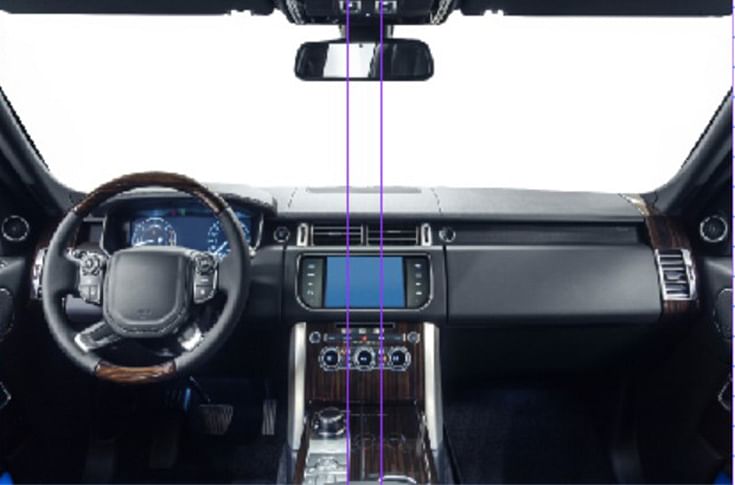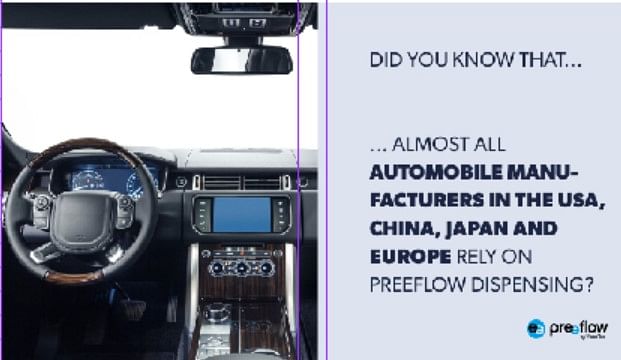Partner Content
Micro dispensing applications for automotive electronics
ViscoTec has a variety of dispensers for micro dispensing applications covering the entire production process with one technology.
Dispensing small and smallest quantities with volumetric precision and speed often presents major challenges for companies in the automotive electronics manufacturing industry. It is not uncommon for industrial manufacturing companies to integrate various dispensing systems from different suppliers into their lines in order to meet the chemical and physical properties of all materials to be mixed and dispensed.

There are a lot of dispensing tasks in automotive electronics components, like displays, sensors, or cameras.
The preeflow® brand, whose dispensing technologies can process silicones, adhesives, greases, oils, resins, sealants, or pastes and much more in the currently widest possible spectrum, works reliably and accurately even at extremely high cycle rates. The preeflow® micro dispensers are used, for example, for manufacturing touch-screens in the car display, sensor technology and electronic components in cars. Here mostly one-component acrylic adhesives with UV or dual cure (light and moisture or heat) and two-component silicones with room temperature curing mechanism are processed.
Application examples
The preeflow® micro dispensers convince in various applications in automotive electronics manufacturing. One example is optical bonding — when manufacturing touch-screens in car displays. When it comes to optical bonding dispensing applications there are a few things to consider. The material to be dispensed must be free of air bubbles when it is dispensed. For this reason, it is necessary to vacuum the material in the material feeding system or during the dosing process. Other requirements for the process can be customer-specific requirements, design, display sizes, environmental influences, or usability.
Another example are sensors in cars (ultrasonic sensors, camera systems and others). The function must be given because sensor errors can cause dangerous accidents.
Benefits of preeflow® dispensing tech
The preeflow® micro dispensers convince with their precise dosing bead application of smallest amounts of one- and two-component fluids and pastes. With more than 99 percent repeatability of dosing processes — the fluids and pastes are dispensed purely volumetric, with no significant change in dosing with fluctuating batches of dosing material. Another plus point is achieving of perfect transitions with closed dispensing beads. The big benefit is from minimum material loss due to dead space optimised and economical dispenser design.

Variety of dispensers
One-component dispensing systems (eco-PEN), spray dispensers (eco-SPRAY) and two-component variants (eco-DUO) are available and based on the operating principle of progressive cavity pumps. They are equally suitable for manual operation and fully automated use. The so-called endless piston principle ensures pulsation-free and purely volumetric dispensing and delivers material of varying viscosity, unchanged throughout the entire process.
The above-mentioned designs are continuously adapted by an internal research and development team to an increasingly wide range of industrially processable materials, considering parameters such as material composition and its viscosity. The dispensing of adhesives — light-curing, thermosetting, anaerobic, shear-sensitive — is just as simple as the application of solder pastes, the application of thermal pastes or the dispensing of LED resins, to name but a few. The programmable suck-back effect guarantees a clean, controlled thread break with any material, without dripping.
One solution for each dispensing task
Constructively, and in view of the need to control technology, different systems are designed specifically for different industrial tasks. Like the other two dispensing systems, the spray dispenser is based on a rotating, completely pressure-tight, displacement system. Defined rotary movements of the rotor displace the material volumetrically in the stator and convey it into a processor-controlled low-flow spray chamber, where precise atomization and spraying takes place. The spray dispenser can be used in manual or automated mode, using low to high viscosity material to create a well-defined edge and with minimal overspray, which can be atomized either continuously or sporadically.
The one-component dispenser was designed for single-component fluid dispensing. Precise dispensing of aqueous to pasty liquids is possible with even the smallest quantities. The technical design allows the one-component dispenser to be used independently of viscosity fluctuations and ensures clean dispensing — in manual operation, as a desktop device, or automated via a control unit.
With two-component dispensers, systems for the traditional processing of various two-component materials can be selected, or a model that is technically adapted to the requirements of materials which are extremely difficult to mix. The classic two-component dispenser is available in three designs, determined by the quantity to be dispensed. Application is either via static mixing elements, in which the two components are mixed before application. Or — perfect for all viscous two-component materials that are difficult to mix — via a mixing capsule with optimized dead space.
Streamlined warehousing, reduced service costs
The technologies mentioned above can be used as stand-alone units or according to the requirements in a production line throughout the entire process. If manufacturers use the different dispensers at different stages in a process, such as traditional bonding and the subsequent spray sealing of the fully assembled board, they benefit from the same active principle at both process steps and invest in process reliability through homogeneous structures. Finally, the use of systems from one brand can significantly simplify the storage of consumables and spare parts. The planning of service calls becomes much easier when using the same technology and ultimately results in a reduction in maintenance costs.
RELATED ARTICLES
Belrise Industries: A Story of Grit and Focus
The Belrise Industries IPO is the culmination of a multi-decade journey by entrepreneur Shrikant Badve that started in a...
Mahindra and Lightweighting: Solid Steel To Nimble Aluminum
Stricter emission regulations and rising fuel efficiency targets are driving a fundamental transformation in powertrain ...
Hero vs Honda: In Numbers
A Comparative Study of Honda Motorcycle & Scooter India and Hero MotoCorp.





 By Autocar Professional Bureau
By Autocar Professional Bureau
 01 Dec 2021
01 Dec 2021
 4756 Views
4756 Views





 Shahkar Abidi
Shahkar Abidi


 Ketan Thakkar
Ketan Thakkar


